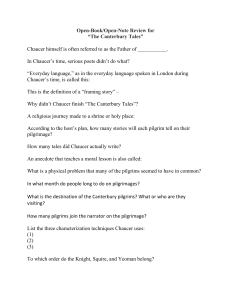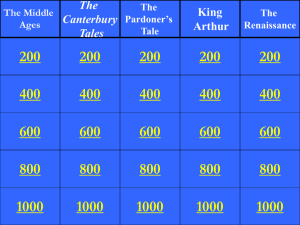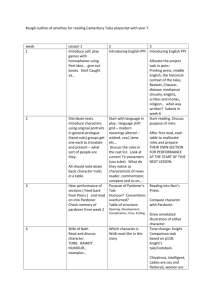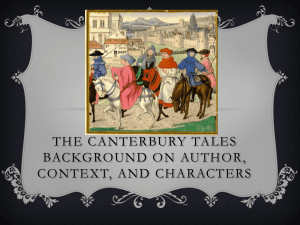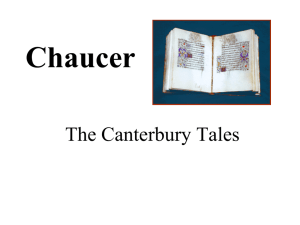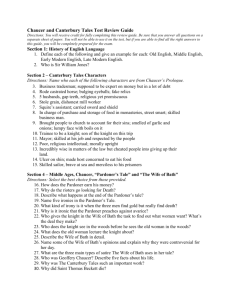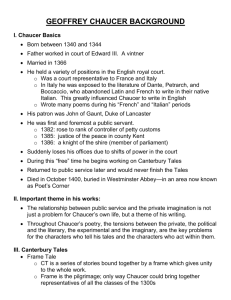Canterbury Tales Packet KEY - McNair
advertisement
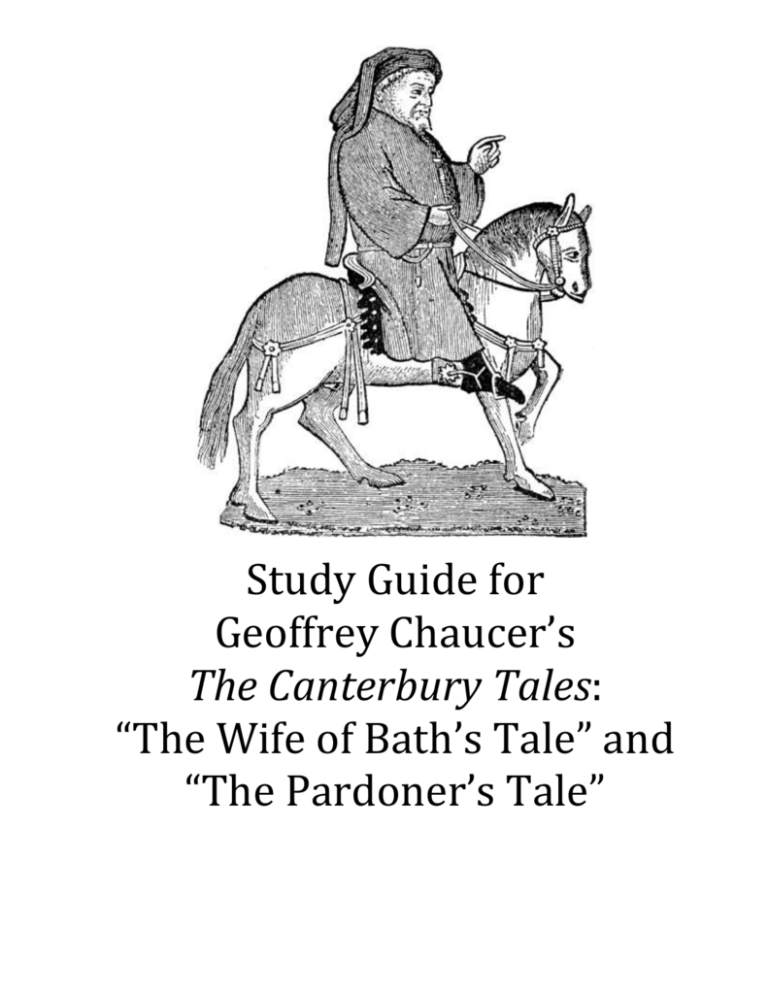
Study Guide for Geoffrey Chaucer’s The Canterbury Tales: “The Wife of Bath’s Tale” and “The Pardoner’s Tale” Notes for Geoffrey Chaucer’s The Canterbury Tales Medieval Narratives (p. 140) Narrative: A type of writing that relates a series of events Ballad: A type of narrative poem that tells a story and has a regular pattern of rhythm and rhyme Medieval Romance: An adventure tale with extravagant characters, exotic places, heroic events, passionate love, and supernatural forces Allegory: A narrative in which every character and event is a symbol that represents an idea, religious principle, or moral Moral Tale: A narrative that illustrates a moral lesson, such as a fable or an exemplum o Fable: a short tale to teach a moral lesson, often with animals or inanimate objects as characters o Exemplum: A short anecdote or story that helps illustrate a particular moral point. Developed in the Middle Ages, this form was widely used by Geoffrey Chaucer in The Canterbury Tales. A theme is an underlying message that a writer wants the reader to understand. Most medieval narratives were religious in theme, but many others were concerned with love, exemplary life and behavior, and political and societal issues. Although comedy and humor are not something often associated with the Middle Ages, the medieval mind had a sophisticated sense of irony and a taste for comic narratives, which were, in fact, common. Characteristics of Chaucer’s Style (pp. 140-141) Chaucer had no illusions about humanity, and yet his works show a compassion and fondness for human nature with all its fault and idiosyncrasies. Though The Canterbury Tales went unfinished, it is the work that best exhibits his unique style, which encompasses a variety of traits. Imagery and Figurative Language: Figurative language communicates ideas beyond the literal meaning of words. Chaucer uses sparse but vivid imagery and figure language to describe his characters’ physical appearance. Irony: The contrast between expectations and reality is known as irony. The ironist seems to be writing with tongue in cheek, and Chaucer is master of it. While calling attention to his characters’ faults, he also emphasizes their essential humanity. This gives his writing a tone of detachment and compassion. o Verbal irony occurs when someone states one thing and means another. o Situational irony is a contrast between what is expected to happen and what actually happens. o In dramatic irony, the readers know more than the characters do. Page 2 Characterization: A writer develops characters by describing their physical appearance, making direct statements about them, and allowing them to express their personalities through dialogue. In The Canterbury Tales, each of Chaucer’s characters is also clearly differentiated by the type of story he or she tells and the voice in which each tale is told. Chaucer’s fame derives in part from his ability to match each pilgrim with his or her tale, as if no other character could have told that story. o o o o Description of each character’s appearance Examples of a character’s speech, thoughts, and actions The responses of others to a character The narrator’s direct comments about a character Frame Story: A literary device that joins together one or more stories within a larger story, or frame. The Canterbury Tales is one of the most famous examples of the frame story. In his innovative use of the device, Chaucer interwove the frame with the tales. The plot of the frame involves pilgrims on a pilgrimage who are challenged to compete in telling the best tale. Chaucer reveals the pilgrims’ personalities not only through their interactions between tales but also by the tales they tell. As a result, the frame itself acts as a long and engaging narrative whole. Geoffrey Chaucer (p. 142) Geoffrey Chaucer made an enormous mark on the language and literature of England. Writing in an age when French was widely spoken in educated circles, Chaucer was among the first writers to show that English could be a respectable literary language. Today, his work is considered a cornerstone of English literature. Befriended by Royalty Born sometime between 1340 and 1343, probably in London, in an era when expanding commerce was helping to bring about growth in villages and cities. Came from a family with means Learned the customs of upper-class life and came into contact with influential people Met John of Gaunt, a leading political figure of the day, who would become Chaucer’s lifelong patron A Knight and a Writer Member of Parliament and knight of the shire Writer Uncommon Honor Buried in London’s Westminster Abbey in 1400 Honored with an elaborate marble monument to his memory in 1556, which was the beginning of the Abbey’s famous Poets’ Corner, where many of England’s most distinguished writers have since been buried Page 3 “THE PROLOGUE” to Geoffrey Chaucer’s The Canterbury Tales Background Notes Time Period: April 1330 Characters: Twenty-nine pilgrims are introduced in Chaucer’s “Prologue” - The “Prologue” describes the pilgrims in detail, and it historically pictures people of the 14th century in England. Three groups are represented by the pilgrims: the feudal, ecclesiastical (church), and urban (city) groups. Meeting Place: Springtime at the Tabard Inn in Southwark, a suburb of London Destination: the shrine of Thomas à Becket located in Canterbury, 59 miles away. Archbishop Thomas à Becket had been killed by men in the service of King Henry II to the shock of the religious world. Saints were revered as intercessors with God, and their shrines were believed to have special curative powers. Reasons for visiting a religious shrine: to seek cures for illness, to gain remission for sins, to satisfy wanderlust (curiosity) Number of Tales: Each pilgrim is to tell two tales on the way to Canterbury and two tales on the return trip to London. The tales are to be judged by the Host, Harry Baley, based on their moral value. The winner of the best tale will receive a dinner at the Tabard Inn paid for by the other pilgrims on their return trip. Chaucer planned to write 124 tales, but he only completed 24 tales before his death around October 1400. The tales are thought to have been inspired by Chaucer’s view from his home above the gates in the wall of London as he watched many processions of travelers. Tone of the Tales: The tales range from moral sermons to somewhat ribald stories. In them, Chaucer incorporates not only irony and comedy but also satire as he uses the pilgrims and their tales to comment on the social problems of his time especially the hypocrisy and worldliness of the church. The only virtuous characters are the Knight, Parson, and Plowman. “The Prologue”: The Prologue reveals the rank and position of each traveler bound for Canterbury. The purpose of the Prologue is to establish the situation and setting (exposition) as well as to sketch out each of the characters. The Prologue also sets the events of the work in motion and makes use of the frame or framework story. This frame story is a unique presentation of a storyline and provides a story within a story. The tales also bring people together from varied occupations and social rankings, presents a cross-section of medieval society, and gives equal scope to Chaucer’s talents as a philosopher, dramatist, and narrator. Pilgrims: All the pilgrims fall into various major divisions of Medieval Society. (See chart on next page.) Page 4 Characters from Geoffrey Chaucer’s The Canterbury Tales British Class Structure circa A.D. 1066 Page 5 The Canterbury Tales: “The Prologue” KEY The Exposition (pp. 144-146) 1. Where does the group gather? The Tabard Inn in Southwark, a town just south of London 2. Where are they going? Why? To the shrine of Saint Thomas à Becket at Canterbury “To seek the holy blissful martyr, quick / to give his help to them when they were sick.” 3. Given what you’ve learned about the medieval period, why were the pilgrims so grateful about welcoming spring? Winter in 14th –century England was especially dark, cold, and brutal. The earth’s climate was going through a long, cold period, which has been dubbed “the Little Ice Age.” The only heat or light available came from the sun, the moon, or fire. The Black Death (1347-1349) was a recent memory and a constant worry. There were outbreaks in 1369, 1374-1375, 1379, and 1390. Medicine was primitive, and superstition was widespread. England lost about 40 percent of its population during that century. Food shortages, which caused hunger and malnutrition, contributed to the general misery. So, too, did the Hundred Years’ War with France and the Peasant’s Revolt (1381). The pilgrims had good cause to hope that their prayers to St. Thomas might allay some of their suffering. (from TE) 4. How many pilgrims are traveling together? 29, plus the Host The Wife of Bath (pp. 156-157) 5. What is the Wife of Bath’s physical infirmity? Somewhat deaf 6. What is her occupation? Seamstress, she was better than the cities famous for manufacturing fine wool fabrics 7. Describe her clothing. What do these details reveal about her character? Rich attire: finely woven kerchiefs, red stockings, soft and new shoes. She must have been a woman of considerable means. Most medieval people wore only hand-me-downs. Old clothing was mended, sold, or cut up and reused to make “new” garments. The expensive clothes of the upper classes were treated as valuable property. 8. Describe her physical appearance. What do these details reveal about her character? “Bold was her face, handsome, and red in hue.” Gap teeth, set widely; large hips. She is attractive to other people. 9. Why does the narrator describe her as “worthy” in lines 455 and 469? The narrator wants to make it clear that he thinks well of her, despite her shortcomings. 10. How many husbands did she have throughout her life? Five Page 6 11. Where has the Wife of Bath traveled? What do these destinations have in common? Jerusalem (three times), Rome, Boulogne, St. James of Compostella, and Cologne; All were popular destinations of religious pilgrimages in the Middle Ages 12. Lines 484-486 say, “In company she liked to laugh and chat /And knew the remedies for love’s mischances, /An art in which she knew the oldest dances.” Explain what these lines mean. What do these details reveal about her character? She knows how to find and keep love because of her life experience. The Wife of Bath is a superlative weaver; she wears stylish and expensive clothes; she has been married five times; and she has traveled to many important pilgrims sites, including three visits to Jerusalem. Therefore, she is a worldy woman with a lot of knowledge about the way people interact. The Pardoner (pp. 162-163) 13. With whom did the Pardoner ride? The Summoner 14. What is a holy relic? An object revered because of its association with a holy person 15. List the relics the Pardoner is carrying with him on the pilgrimage. A holy relic on his cap A pillowcase which he asserted was Our Lady’s veil (the kerchief of the Virgin Mary) Cross of metal set with stones A rubble of pigs’ bones in a glass 16. What does the Pardoner do with the relics? What purpose do they serve? He uses these relics to fool the naïve populace of country parishes, where he could make more money in a day than their parson could make in a month or two. 17. Why is this purpose ironic? As a man of the church, he made fools of the priest and his congregation by using flattery and lies. 18. What did the Pardoner get from the Court of Rome? A “brimful of pardons, all hot” 19. Give evidence that proves that the Pardoner is good at getting money from people. He could make more money in a day than their parson could make in a month or two. “Tune his honey-tongue / And (well he could) win silver from the crowd” The Host (pp. 164-165) 20. Describe the Host’s physical appearance. Very striking, bright eyes, wide girth 21. Describe his personality. “Bold in speech, yet wise and full of tact, / There was no manly attribute he lacked.” Page 7 The Plan (pp. 165-166) 22. What idea does the Host have to pass the time while the pilgrims travel to Canterbury? Each pilgrim tell two stories on the way to Canterbury and two stories on the way back from Canterbury. 23. How will the Host decide the winner? Story that is best told, the one who gives the fullest measure of good morality and general pleasure. 24. What will the winner receive? The winner will receive a supper at the Tabard Inn, paid by all of the other pilgrims. The Canterbury Tales “The Pardoner’s Prologue and Tale” Answer Key Literary Analysis: Exemplum An exemplum is a short anecdote or story that illustrates a particular moral point. Developed in the late Middle Ages, this literary form was often used in sermons and other didactic literature. One famous example is Chaucer’s “The Pardoner’s Tale,” which focuses on the subject of greed. As you read the selection, pay attention to the actions of the characters and to the narrator’s description of his own practices. “The Pardoner’s Prologue” (pp. 170-172) 25. What is a pardoner? In the medieval church, a pardoner was a clergy member who had authority from the pope to grant indulgences – certificates of forgiveness – to people who showed great charity. 26. Were all pardoners ethical? Explain. No. In practice, many pardoners – such as Chaucer’s pilgrim – were unethical and sold their certificates to make money for the church or themselves. 27. Translate “Radix malorum est cupiditas…” from line 8, and then explain what it means. Latin for “The love of money is the root of all evil” (I Timothy 6:10). Greed is the cause of most problems. 28. Define avarice. Greed 29. In lines 16-22, in what way is the Pardoner’s choice of the topic of avarice for his tale a sign of his corruption? The Pardoner is telling a sermon about greed, and his sole motive is greed. The topic itself makes poor people more willing to give up their money. His ulterior motive in choosing this topic is a sign of his corruption. 30. Define castigate. To criticize severely, to berate Page 8 31. Review lines 39-47. Why does the Pardoner tell his moral stories? Explain how his motive is ironic, or different from what you might have expected. The Pardoner tells his moral stories not to help sinners but to help himself. He’s greedy and wishes to scare people into buying his indulgences and relics. 32. In lines 50-57, why does the Pardoner admit his own corruption? The Pardoner wants the other pilgrims to acknowledge that, despite the fact that his is immoral (line 55), he can still tell a moral tale (line 56). One criterion for winning the storytelling contest is that it must be entertaining; the other is that it must have a strong moral – “the fullest measure of good morality and general pleasure” (“The Prologue,” lines 817-818). The Pardoner does not want to lose the contest because of his depraved character. His admission contributes to the irony. “The Pardoner’s Tale” (pp. 173-182) 33. Where are the three men? What are they doing? Sitting in a tavern having a drink. 34. What did they hear going through the street? A hand-bell clink from a coffin. In Chaucer’s time, a bell was carried beside the coffin in a funeral procession. 35. To what plague does the story refer? How many people in Europe were killed by this plague during the mid-14th century? The Bubonic plague killed at least a quarter of the population of Europe in the mid-14th century. 36. Many characters in moral stories are allegorical – that is, they stand for abstract ideas, such as virtue and beauty. Identify the allegorical character presented in lines 72-89. Who fears him? Why? The allegorical character is Death. The tavern-knave, the innkeeper, and the townspeople are all afraid of death because the plague has struck and taken many lives. 37. What do the rioters decide to do? They decide to kill this traitor Death. 38. What qualities of the three men does Chaucer emphasize in lines 93-107? What do you think may happen to them as a result of these qualities? Chaucer emphasizes the rioters’ drunkenness, anger, impulsiveness, overconfidence, and violent language. They will likely turn on each other. 39. Who do the men meet along the road? How do they treat the person that they meet? What does this reveal about the men? An old man. They show him no respect and even threaten to harm him. Their mistreatment of the old man underscores their crudeness, recklessness, and lack of judgment. 40. A foil is a character who provides a striking contrast to other characters. In what way does the old man serve as a foil to the three rioters? He is a foil to the rioters in that he represents the wisdom of old age. Unlike the rioters, the old man is calm, sober, and respectful; he understands that human beings have no control over death. Page 9 41. What purposes do the story of his life and his views about death serve? They serve as a cautionary tale to the reckless rioters who are searching for Death: The old man has also been searching – for a young person to trade youth for old age. The old man’s search has been fruitless. His pleas for death have also gone unanswered. The old man’s example suggests that people have no control over death. Any effort to gain control is as pointless as trying to trade old age for youth. 42. Lines 141-143 say, “It says in holy writ, as you may read, / ‘Thou shalt rise up before the hoary head / And honor it.’” Explain what these lines mean. Hoary means “gray or white with age”, so you are to honor your elders. 43. To best illustrate a moral point, characters in an exemplum are usually good or evil. To which category does the gambler seem to belong? Explain. The gambler seems to be an evil character. He shows nothing but contempt for the old man. He insults him, threatens him (lines 150 and 155), and accuses him of working for Death (lines 154, 157-158). 44. Where does the old man tell them to find Death? Under a tree 45. What do they find there? What is its worth? A pile of gold florins (coins) on the ground, new-coined, eight bushels of them. 8 bushels worth $.24 a piece 46. In what way is the discovery the rioters make ironic, or different from what you had anticipated? One might expect the rioters to discover a frightful person, beast, or other personification of Death under the tree. Instead, they find gold. 47. Why do they draw lots? To decide who will go to town to buy bread and wine 48. How do you think the three men will react to the challenge of sharing their treasure? The men will probably turn on each other. Each will want to keep the gold for himself. 49. A parley is generally a discussion or a conference between opponents. In what way is this conversation a parley? The two men are not friends; they are in fact opponents, one trying to rob the others. 50. In lines 207-229, is the rioters’ corruption surprising? Explain. The rioters have shown themselves to be untrustworthy thieves without conscience. The plot to gang up on and kill one of the “brothers” is no surprise. 51. Explain the irony in lines 221-222: “‘Trust me,’ the other said, ‘you needn’t doubt / My word. I won’t betray you, I’ll be true.’” He is asking for trust from one person as he’s betraying another. (dramatic irony) 52. What plan do the two remaining rioters make? To kill the other man when he returns from town Page 10 53. Which details in lines 236-242 tell you that greed is the subject of this moral story? The youngest rioter thinks only of the gold coins, without consideration for the mortal sin he plans to commit. 54. In lines 243-259, how does the youngest rioter’s level of corruption compare to that of his friends? The youngest rioter seems to be every bit as corrupt as his friends. 55. An apothecary is a person who prepares and sells drugs or compounds for medicinal purposes, a chemist or pharmacist. What does the young rioter buy from him? Rat poison to kill the other two rioters 56. What happens to the young man after he returns from town? What happens to the two remaining rioters? The youngest rioter poisons the wine, but the other rioters stab him before they drink the wine. Then the two drink the tainted wine and die. 57. Moral stories usually straightforward plots, where events happen in quick succession. In what way does the story’s conclusion fit this pattern? The events leading to the story’s conclusion happen quickly: The youngest rioter poisons the wine, but the other rioters stab him before they drink the wine. Then the two drink the tainted wine and die. 58. How does the rioters’ end support the lesson that the desire for money is the root of evil? The rioters’ evil ways are driven by their desire for gold. They all meet terrible ends because of their greed. 59. Do the rioters get what they deserve? Yes; each of the murderers is murdered himself. Their punishment seems fitting and just. 60. In what way does the Pardoner reveal his corruption in the end? He continues his usual pitch and tries to sell pardons to the pilgrims who have just heard his tale. 61. Is the Pardoner being serious or facetious (“not meant to be taken seriously or literally”) at this point? Though he may hope that his tale will have the same effect on the pilgrims that it does on “yokel minds,” the Pardoner knows it probably won’t. 62. Why do you think Chaucer decided to have a corrupt narrator, the Pardoner, relate this tale? Chaucer suggests that even those that warn of the dangers of corruption may be guilty of it themselves. Page 11 Chaucer is widely admired for his skillful use of irony – the discrepancy between what appears to be true and what actually is true. For each type of irony, provide an example from “The Pardoner’s Tale.” Irony Example(s) from “The Pardoner’s Tale 63. Verbal irony occurs when someone The Pardoner makes a speech at the end of the selection, states one thing and means another. when he tries to sell forgiveness; by his earlier admission, he doesn’t believe in the church’s teachings about sin, forgiveness, and damnation. 64. Situational irony is a contrast The rioters expect to find Death under the tree; instead between what is expected to happen they find gold, which leads to their death. and what actually happens. 65. In dramatic irony, the readers know The reader is aware that the older rioters have conspired more than the characters do. against the youngest. 66. After completing the chart, how essential is irony to the meaning of the story? Through the use of irony, Chaucer uncovers the hypocrisy of the Catholic Church, the Pardoner, and the rioters. Thus, irony is essential to the story. 67. During the mid-14th century, the Black Death – a massive epidemic of the bubonic plague – swept through Asia and Europe. In Europe alone, one-quarter of the population died. In what way might these circumstances have made people vulnerable to the tricks of the Pardoner and other unscrupulous clergymen? Christians would have feared dying without forgiveness for their sins, as doing so would have meant eternal damnation. The outbreak of the plague would have led many to seek forgiveness in the form of indulgences. They might also have looked to the supposed power of his relics to keep them healthy. 68. What theme, or central message, about corruption do you think Chaucer conveys in this story? How does it still hold true today? Chaucer seems to suggest that greed lies at the heart of much corruption. It is greed that drives the corrupt behavior of both the Pardoner and the characters in his tale. This theme applies to today’s headlines about corruption and greed within large corporations. Page 12 The Canterbury Tales “The Wife of Bath’s Prologue and Tale” Teacher Key Literary Analysis: Narrator The narrator of a story is the character or voice that relates the story’s events to the reader. Many narrators have distinct personalities that are revealed through the subject matter, tone, and language of their stories. In this selection, the narrator is the Wife of Bath, one of the most charismatic characters in The Canterbury Tales – and, arguably, in all of English literature. As you read, notice what she reveals about herself and medieval society in her lively tale. Background: Education and Literacy in the Middle Ages Chaucer died about a half-century before the invention of movable type. Nevertheless, literacy was very slowly becoming more widespread in the 14th century. The main reasons were economic and bureaucratic: people depended more and more on written records. Property transactions and agricultural production, for example, were often recorded. So too, were wills, surveys, deeds, and other financial dealings. Readers held a great advantage over those who could not read. Illiterate farmers might find themselves at the mercy of corrupt officials. The number of school increased and universities were established. Even so, most people in England were unable even to sign their names. Among women, no more than one percent could read in Chaucer’s day. The Wife of Bath, with her extensive knowledge, was an anomaly. Chaucer’s educated audience would have been well aware of this fact. “The Wife of Bath’s Prologue” (p. 184) 69. In lines 7-21, the narrator introduces the subject of her tale – marriage and its many difficulties. What personal opinions and experiences does she also reveal? The Wife of Bath offers the opinion that the Pardoner should be careful about marrying. She bases her opinion on her significant experience with marriage. 70. In lines 22-25, what understanding of women does the Pardoner hope to gain from the Wife of Bath’s tale? He hopes to gain some practical knowledge about marriage, based on experience. “The Wife of Bath’s Tale” (pp. 186-196) 71. In lines 57-64, how does the opening of the Wife of Bath’s tale illustrate an extreme case of a man who has no understanding of women? The knight dominates the maiden by brute force (rapes), ignoring her entreaties. 72. Review the Medieval Code of Chivalry. How does this act conflict with the chivalric code? The code says “to respect the honor of women.” He dishonors the woman by raping her. 73. What did the king plan to do to the knight as punishment for this act? He condemned the knight to lose his head by course of law. 74. Define implore. To plead; to beg 75. What does the queen require of him so that he can avoid the king’s punishment? To live, he has one year and a day to answer the question, “what is the thing that women most desire?” Page 13 76. In lines 101-124, the knight finds many different opinions on understanding women’s one desire. What are they? Women want wealth (line 101), treasure (line 101), honor (line 102), fun (line 103), pleasure (line 102), clothing (line 103), many husbands (line 104), pampering (line 106), flattery (lines 106-110), freedom (line 112), a lack of criticism (line 113-120), and the trust of others, even if it’s not deserved (lines 121-127) 77. The Wife of Bath digresses, or wanders, from her story about the knight in lines 128-158 to tell the story of King Midas and his wife. What are some of the purposes of this interruption? Building suspense and of showing her literary knowledge and worldliness Provides comic relief from a story about a debauched male who must find out what women want in order to avoid a death sentence Acknowledges, in a humorous way to her mostly male audience, that women aren’t perfect, either 78. Define crone. An ugly old woman 79. Define sovereignty. Rule; power 80. According to lines 181-216, what is the key to an understanding of women? A women wants power over her husband. Background: The Economics of Knighthood Knighthood was on the wane in the age of Chaucer. The number of knights had dropped from about five thousand in 1100 A.D. to about eleven hundred in the year 1300. The problem: The cost of knighthood was so high. Equipment – especially armor and horses – was very expensive. In the 12th century, knights were members of a military order that included peasants as well as nobles. By Chaucer’s day, most knights were aristocrats, the only class who could afford the cost of knighthood. The status attached to knighthood had more to do with greatness of wealth than with abundance of chivalry. 81. What deal does the knight make with the old woman he meets, and how does he fulfill his bargain with her? In exchange for the correct answer to the queen’s question, the knight will do whatever the old woman asks of him. To fulfill the bargain, he marries her, because that is her demand. 82. What are the knight’s reasons for not being able to love his new wife? He says she is old, plain, poor, and lowbred. 83. What choices does the knight’s wife give him? She says he can choose to have her old, ugly, but loyal until she dies or he can have her young and pretty and take his chances on her loyalty. 84. Define bequeath. To leave in a will; to pass down as an inheritance Page 14 85. Define temporal. Of the material world; not eternal 86. According to the Wife of Bath, what gives a man the distinction of being a great gentleman? Virtuous deeds, rather than high birth, make a great gentleman. 87. Define gentility. Why does the old lady feel it necessary to explain her ideas about gentility to the knight? Gentility is the quality possessed by a gentle, or noble, person. The knight has been treating the old lady rudely she is not high born, rather than showing her gratitude for saving his life. 88. What arguments does the old woman use to put the knight to shame? The old lady’s instructive comments illustrate why she believes that the knight is no gentleman. She repeats that noble deeds, rather than high birth, are signs of gentility, and that poverty is neither shameful nor bad. 89. Why does the old woman’s speech (lines 285-394) go on for so long? The old woman is very angry, hurt, and annoyed by the knight’s crude, ungrateful behavior toward her; she seems to be at wit’s end. Perhaps she wants to give the knight one last chance to change. 90. Define rebuke. To criticize 91. In lines 285-394, the old woman offers a lengthy rebuttal to the knight’s complaints. Why might the narrator place the focus on the old woman and not the knight at this point in the story? The narrator focuses on the old woman because she is the only one who can deliver the moral of the tale; the knight has proven by his actions and behavior that he is still churlish and meanspirited. Only the old woman has something to teach, while the knight still has much to learn. 92. In lines 346-388, is the old woman helping the knight to gain an understanding that goes beyond “what women most desire”? Explain. The old woman is helping him to understand what makes a good man: a person who is dignified in his actions and manners and is respectful of others. 93. When he agrees with her and kisses her, what happens? She turns into a young, beautiful, charming woman. 94. Reread the last paragraph. What is the Wife of Bath’s attitude toward husbands who are controlling or misers? The Wife of Bath’s attitude toward controlling or miserly husbands is negative and hostile. She asks that Jesus cut short the lives of controlling husbands (lines 437-438) and that God cause miserly husbands to die of pestilence (lines 439-440). Characteristics of the Medieval Romance Opens with a feast Involves a challenge or quest: The knight has to find out what women most desire. Tells the adventures of a hero: The knight, though flawed, is the hero of the story. Involves supernatural elements: The old woman turns young and beautiful at the end. Teaches the hero a moral lesson: The knight learns the errors of his ways and thoughts. Includes women as temptresses Page 15 95. How does this tale fit the characteristics of a medieval romance? See above. 96. Review lines 404-432. Is the conclusion of the story satisfying? In your response, consider the knight’s crime and the outcome of his actions. Answers will vary. I do not like the conclusion because everything turns out to be wonderful for a rapist! 97. Do you think the Wife of Bath was ahead of her time or behind the times with regard to her attitude toward gender roles? The Wife of Bath was ahead of her time, as she spoke out against men’s control of women’s lives in her 14th-century society. 98. Around 1185, Andreas Capellanus wrote The Art of Courtly Love. In this influential work, Capellanus states, “Love makes an ugly and rude person sine with all beauty, knows how to endow with nobility even one of humble birth, can even lend humility to the proud.” In what ways does “The Wife of Bath’s Tale” reflect Capellanus’s understanding of love and its transforming power? Through love, the crone becomes beautiful and the knight becomes humble and good-hearted. Page 16
